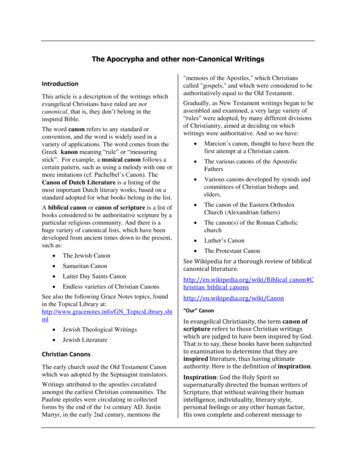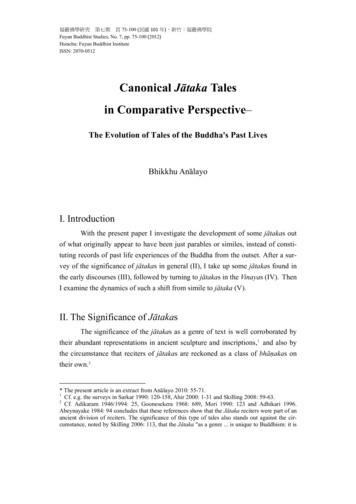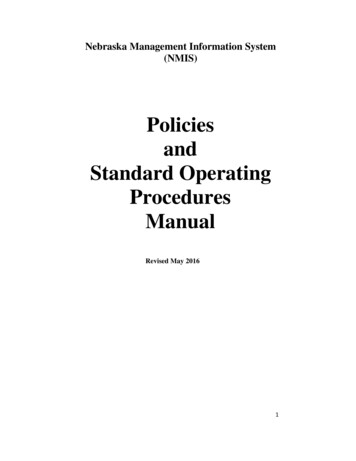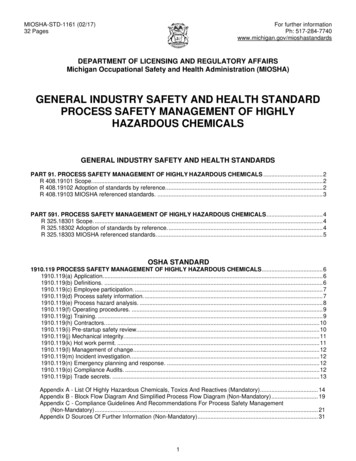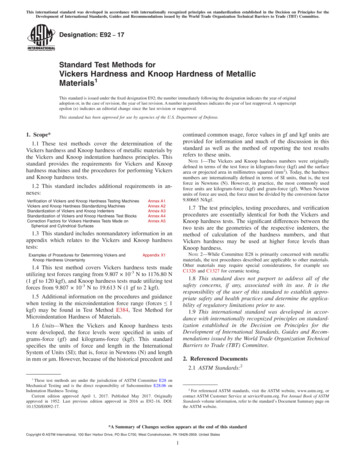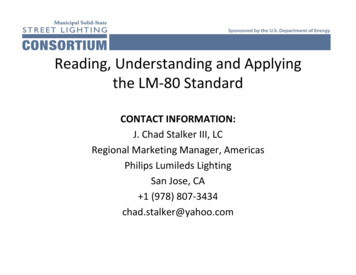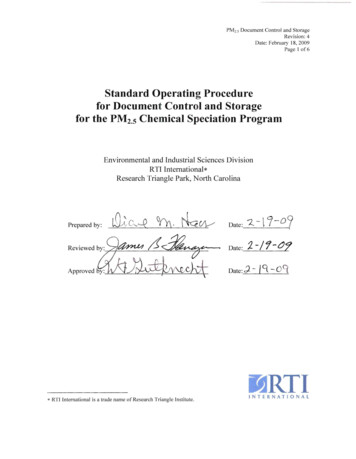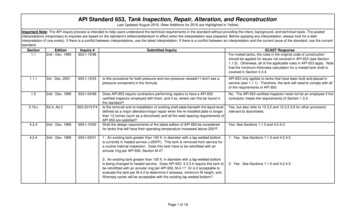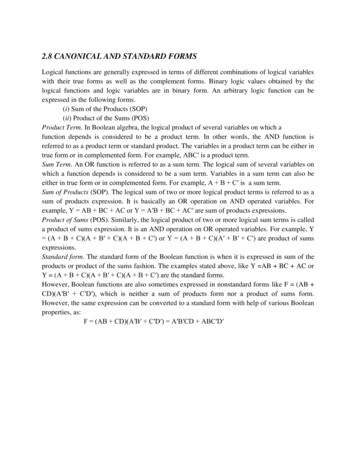
Transcription
2.8 CANONICAL AND STANDARD FORMSLogical functions are generally expressed in terms of different combinations of logical variableswith their true forms as well as the complement forms. Binary logic values obtained by thelogical functions and logic variables are in binary form. An arbitrary logic function can beexpressed in the following forms.(i) Sum of the Products (SOP)(ii) Product of the Sums (POS)Product Term. In Boolean algebra, the logical product of several variables on which afunction depends is considered to be a product term. In other words, the AND function isreferred to as a product term or standard product. The variables in a product term can be either intrue form or in complemented form. For example, ABC′ is a product term.Sum Term. An OR function is referred to as a sum term. The logical sum of several variables onwhich a function depends is considered to be a sum term. Variables in a sum term can also beeither in true form or in complemented form. For example, A B C′ is a sum term.Sum of Products (SOP). The logical sum of two or more logical product terms is referred to as asum of products expression. It is basically an OR operation on AND operated variables. Forexample, Y AB BC AC or Y A′B BC AC′ are sum of products expressions.Product of Sums (POS). Similarly, the logical product of two or more logical sum terms is calleda product of sums expression. It is an AND operation on OR operated variables. For example, Y (A B C)(A B′ C)(A B C′) or Y (A B C)(A′ B′ C′) are product of sumsexpressions.Standard form. The standard form of the Boolean function is when it is expressed in sum of theproducts or product of the sums fashion. The examples stated above, like Y AB BC AC orY (A B C)(A B′ C)(A B C′) are the standard forms.However, Boolean functions are also sometimes expressed in nonstandard forms like F (AB CD)(A′B′ C′D′), which is neither a sum of products form nor a product of sums form.However, the same expression can be converted to a standard form with help of various Booleanproperties, as:F (AB CD)(A′B′ C′D′) A′B′CD ABC′D′
2.8.1 MintermA product term containing all n variables of the function in either true or complemented form iscalled the minterm. Each minterm is obtained by an AND operation of the variables in their trueform or complemented form. For a two-variable function, four different combinations arepossible, such as, A′B′, A′B, AB′, and AB. These product terms are called the fundamentalproducts or standard products or minterms. In the minterm, a variable will possess the value 1 ifit is in true or uncomplemented form, whereas, it contains the value 0 if it is in complementedform. For three variables function, eight minterms are possible as listed in the following table inFigure 2.9.Figure 2-9So, if the number of variables is n, then the possible number of minterms is 2n. The mainproperty of a minterm is that it possesses the value of 1 for only one combination of n inputvariables and the rest of the 2n – 1 combinations have the logic value of 0. This means, for theabove three variables example, if A 0, B 1, C 1 i.e., for input combination of 011, there isonly one combination A′BC that has the value 1, the rest of the seven combinations have thevalue 0.Canonical Sum of Product Expression. When a Boolean function is expressed as thelogical sum of all the minterms from the rows of a truth table, for which the value of the functionis 1, it is referred to as the canonical sum of product expression. The same can be expressed in acompact form by listing the corresponding decimal-equivalent codes of the minterms containinga function value of 1. For example, if the canonical sum of product form of a three-variable logicfunction F has the minterms A′BC, AB′C, and ABC′, this can be expressed as the sum of thedecimal codes corresponding to these minterms as below.F (A,B,C) (3,5,6) m3 m5 m6 A′BC AB′C ABC′
where Σ (3,5,6) represents the summation of minterms corresponding to decimal codes 3, 5, and6.The canonical sum of products form of a logic function can be obtained by using the followingprocedure:1. Check each term in the given logic function. Retain if it is a minterm, continue toexamine the next term in the same manner.2. Examine for the variables that are missing in each product which is not a minterm.If the missing variable in the minterm is X, multiply that minterm with (X X′).3. Multiply all the products and discard the redundant terms.Here are some examples to explain the above procedure.Example 2.6. Obtain the canonical sum of product form of the following function:F (A, B) A BSolution. The given function contains two variables A and B. The variable B is missing from thefirst term of the expression and the variable A is missing from the second term of the expression.Therefore, the first term is to be multiplied by (B B′) and the second term is to be multiplied by(A A′) as demonstrated below.F (A, B) A B A.1 B.1 A (B B′) B (A A′) AB AB′ AB A′B AB AB′ A′B(as AB AB AB)Hence the canonical sum of the product expression of the given function isF (A, B) AB AB′ A′B.Example 2.7. Obtain the canonical sum of product form of the following function.F (A, B, C) A BCSolution. Here neither the first term nor the second term is minterm. The given function containsthree variables A, B, and C. The variables B and C are missing fromthe first term of the expression and the variable A is missing from the second term of theexpression. Therefore, the first term is to be multiplied by (B B′) and (C C′). The secondterm is to be multiplied by (A A′). This is demonstrated below.F (A, B, C) A BC A (B B′) (C C′) BC (A A′) (AB AB′) (C C′) ABC A′BC ABC AB′C ABC′ AB′C′ ABC A′BC ABC AB′C ABC′ AB′C′ A′BC (as ABC ABC ABC)Hence the canonical sum of the product expression of the given function isF (A, B,C) ABC AB′C ABC′ AB′C′ A′BC.
2.8.2 MaxtermA sum term containing all n variables of the function in either true or complemented form iscalled the maxterm. Each maxterm is obtained by an OR operation of the variables in their trueform or complemented form. Four different combinations are possible for a two-variablefunction, such as, A′ B′, A′ B, A B′, and A B. These sum terms are called the standardsums or maxterms. Note that, in the maxterm, a variable will possess the value 0, if it is in true oruncomplemented form, whereas, it contains the value 1, if it is in complemented form. Likeminterms, for a three-variable function, eight maxterms are also possible as listed in thefollowing table in Figure 2.10.Figure 2-10So, if the number of variables is n, then the possible number of maxterms is 2n. The mainproperty of a maxterm is that it possesses the value of 0 for only one combination of n inputvariables and the rest of the 2n –1 combinations have the logic value of 1. This means, for theabove three variables example, if A 1, B 1, C 0 i.e., for input combination of 110, there isonly one combination A′ B′ C that has the value 0, the rest of the seven combinations havethe value 1.Canonical Product of Sum Expression. When a Boolean function is expressed as the logicalproduct of all the maxterms from the rows of a truth table, for which the value of the function is0, it is referred to as the canonical product of sum expression. The same can be expressed in acompact form by listing the corresponding decimal equivalent codes of the maxterms containinga function value of 0. For example, if the canonical product of sums form of a three-variablelogic function F has the maxterms A B C, A B′ C, and A′ B C′, this can be expressedas the product of the decimal codes corresponding to these maxterms as below,F (A,B,C) Π (0,2,5) M0 M2 M5 (A B C) (A B′ C) (A′ B C′)
where Π (0,2,5) represents the product of maxterms corresponding to decimal codes 0, 2, and 5.The canonical product of sums form of a logic function can be obtained by using thefollowing procedure.1. Check each term in the given logic function. Retain it if it is a maxterm, continue toexamine the next term in the same manner.2. Examine for the variables that are missing in each sum term that is not a maxterm.If the missing variable in the maxterm is X, add that maxterm with (X.X′).3. Expand the expression using the properties and postulates as described earlier anddiscard the redundant terms.Some examples are given here to explain the above procedure.Example 2.8. Obtain the canonical product of the sum form of the following function.F (A, B, C) (A B′) (B C) (A C′)Solution. In the above three-variable expression, C is missing from the first term, Ais missing from the second term, and B is missing from the third term. Therefore, CC′ is to beadded with first term, AA′ is to be added with the second, and BB′ is to be added with the thirdterm. This is shown below.F (A, B, C) (A B′) (B C) (A C′) (A B′ 0) (B C 0) (A C′ 0) (A B′ CC′) (B C AA′) (A C′ BB′) (A B′ C) (A B′ C′) (A B C) (A′ B C) (A B C′) (A B′ C′)[using the distributive property, as X YZ (X Y)(X Z)] (A B′ C) (A B′ C′) (A B C) (A′ B C) (A B C′)[as (A B′ C′) (A B′ C′) A B′ C′]Hence the canonical product of the sum expression for the given function isF (A, B, C) (A B′ C) (A B′ C′) (A B C) (A′ B C) (A B C′)Example 2.9. Obtain the canonical product of the sum form of the following function.F (A, B, C) A B′CSolution. In the above three-variable expression, the function is given at sum of the productform. First, the function needs to be changed to product of the sum form by applying thedistributive law as shown below.F (A, B, C) A B′C (A B′) (A C)Now, in the above expression, C is missing from the first term and B is missing fromthe second term. Hence CC′ is to be added with the first term and BB′ is to be added with thesecond term as shown below.F (A, B, C) (A B′) (A C) (A B′ CC′) (A C BB′) (A B′ C) (A B′ C′) (A B C) (A B′ C)[using the distributive property, as X YZ (X Y) (X Z)]
(A B′ C) (A B′ C′) (A B C)[as (A B′ C) (A B′ C) A B′ C]Hence the canonical product of the sum expression for the given function isF (A, B, C) (A B′ C) (A B′ C′) (A B C).2.8.3 Deriving a Sum of Products (SOP) Expression from a Truth TableThe sum of products (SOP) expression of a Boolean function can be obtained from itstruth table summing or performing OR operation of the product terms corresponding to thecombinations containing a function value of 1. In the product terms the input variables appeareither in true (uncomplemented) form if it contains the value 1, or in complemented form if itpossesses the value 0.Now, consider the following truth table in Figure 2.11, for a three-input function Y. Here theoutput Y value is 1 for the input conditions of 010, 100, 101, and 110, and their correspondingproduct terms are A′BC′, AB′C′, AB′C, and ABC′ respectively.Figure 2-11The final sum of products expression (SOP) for the output Y is derived by summingor performing an OR operation of the four product terms as shown below.Y A′BC′ AB′C′ AB′C ABC′In general, the procedure of deriving the output expression in SOP form from a truth table can besummarized as below.1. Form a product term for each input combination in the table, containing an output value of 1.2. Each product term consists of its input variables in either true form or complemented form. Ifthe input variable is 0, it appears in complemented form and if the input variable is 1, it appearsin true form.3. To obtain the final SOP expression of the output, all the product terms are OR operated.
2.8.4 Deriving a Product of Sums (POS) Expression from a Truth TableAs explained above, the product of sums (POS) expression of a Boolean function can also beobtained from its truth table by a similar procedure. Here, an AND operation is performed on thesum terms corresponding to the combinations containing a function value of 0. In the sum termsthe input variables appear either in true (uncomplemented) form if it contains the value 0, or incomplemented form if it possesses the value 1.Now, consider the same truth table as shown in Figure 2.11, for a three-input functionY. Here the output Y value is 0 for the input conditions of 000, 001, 011, and 111, andtheir corresponding product terms are A B C, A B C′, A B′ C′, and A′ B′ C′respectively.So now, the final product of sums expression (POS) for the output Y is derived by performing anAND operation of the four sum terms as shown below.Y (A B C) (A B C′) (A B′ C′) (A′ B′ C′)In general, the procedure of deriving the output expression in POS form from a truth table can besummarized as below.1. Form a sum term for each input combination in the table, containing an output value of 0.2. Each product term consists of its input variables in either true form or complementedform. If the input variable is 1, it appears in complemented form and if the input variable is 0, itappears in true form.3. To obtain the final POS expression of the output, all the sum terms are ANDoperated.2.9.5 Conversion between Canonical FormsFrom the above example, it may be noted that the complement of a function expressedas the sum of products (SOP) equals to the sum of products or sum of the minterms which aremissing from the original function. This is because the original function is expressed by thoseminterms that make the function equal to 1, while its complement is 1 for those minterms whosevalues are 0. According to the truth table given in Figure 2.11:F (A,B,C) Σ ( 2,4,5,6) m2 m4 m5 m6 A′BC′ AB′C′ AB′C ABC′.This has the complement that can be expressed asF′ (A,B,C) (0,1,
The canonical sum of products form of a logic function can be obtained by using the following procedure: 1. Check each term in the given logic function. Retain if it is a minterm, continue to examine the next term in the same manner. 2. Examine for the variables that are missing in each product which is not a minterm. If the missing variable in the minterm is X, multiply that minterm with (X X .

